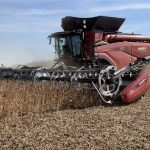Modern combines are flexing their technology side with each passing model year.
Harvest season is a hectic time of year and the technology behind that sophistication is often designed to make combine operation more fluid and trouble-free.
We asked some of the attendees on the show grounds of Canada’s Outdoor Farm Show in Woodstock, Ont., what were some features that stood out for them at harvest season.
Read Also

Maizex brings Elite forage seeds under its brand umbrella
The seed catalogue for Maizex Seeds takes on a different look for its 2026 edition thanks to the introduction of a new marketing initiative dubbed “Ration 365.”
Their responses ranged from improved visibility from the driver’s seat, cab comfort, to something as seemingly simple as how the unloading auger folded against the rear of the combine.
One attendee mentioned that the joystick steering control — in place of a traditional steering wheel — in his Fendt combine was a challenge to use at first, but he now loved it.
So, what better place than an outdoor farm show to ask machinery manufacturers what technology features stood out on their combines that help farmers at harvest-time.
Hear what they had to share in the videos and text below.
Case IH
Case IH had its AF9 combine on the show grounds of Canada’s Outdoor Farm Show.
The AF9 produces 634 engine horsepower and has a new, larger single rotor to increase capacity and reduce grain loss at the rotor.
Mark Robson, harvesting specialist with Case IH, shared what technology he felt stood out on the company’s combine offerings.
“On our 60 Series flagship (combine), our 7270 or 82 and 9260 our AF 9, 10 and 11, we have our FieldOps as standard equipment,” said Robson. “FieldOps gives you all your real time data of where your machine is, what fuel it’s using, fault codes, yield data, all that coming live onto your apps on your phone or your computer.”
Robson followed up with Harvest Command being the next most important tech offering for combine operators in the field.
Using a camera system, Harvest Command highlights what is not grain and also highlights damaged grain.
“Our Harvest Command is our grain automation,” said Robson. “It will sense the feeder load, sense the engine load, sense your losses, sense your capacity, and make adjustments to those and look at your grain sample.”
Robson said that Harvest Command is available on all Case IH combines, including the brand’s 160 Series legacy combines.
New Holland
New Holland had its flagship CR11 twin rotor combine on the show grounds at Canada’s Outdoor Farm Show.
The CR11’s turbocharged FPT Cursor 16 engine puts out 775 horsepower. It’s a big machine and many folks stepped up into the driver’s seat to kick the tires — or tracks in this case — to learn more about what this combine was capable of.
For Trevor Overstreet, product specialist with New Holland, the intelligence of the CR11 is what stands out.
“I really like our IntelliSense and IntelliCruise options,” said Overstreet. “IntelliSense adjust the guts of the combine, so everything but the concaves you’re adjusting.”
Overstreet said that IntelliSense automatically adjusts rotor speed, rotor vanes, sieves and fan speed to allow operators to get the most done when harvesting in the field.
IntelliCruise is a feed rate control system that adjusts the combine’s speed so that the crop is entering the combine at the right amount. This helps to avoid grain loss and avoid plugging the feed system.
2025 also marks New Holland’s 50 year anniversary of the Twin Rotor design on its combines.
“Since 1975 we’ve been doing twin rotor design with match width feeding, so it’s the same width all the way through the combine,” said Overstreet. “That was revolutionary 50 years ago, and we’ve been just building on this.”
John Deere
Standing beside a John Deere S7 combine, Dennis Jansen, production system specialist for John Deere, highlighted a particular package that the green brand offers on its combines.
“If you order a John Deere combine with the ultimate tech package, there’s three main things that we get,” said Jansen.
Deere’s technology package leans heavily on automation to help eliminate errors in decision-making and to improve productivity in the field.
Terrain Settings Automation senses when a combine is going up or down a hill and automatically adjusts harvest features to be more efficient in those situations.
Harvest Settings Automation allows the combine to be set up based on parameters an operator considers acceptable for grain loss, foreign material and broken grains.
“On the combine we’ve got some loss sensors at the back of the cleaning shoe and the rotor,” said Jansen. “We’ve got some cameras that are on the clean grain elevator and the tailings elevator, and depending on the crop that we’re in, they monitor our loss levels and monitor the quality of the grain.”
This information feeds into the system and the combine’s settings automatically adjust depending on the criteria the operator has laid out for it.
The third piece in the package is Predictive Ground Speed Automation.
“On the front of the cab there’s two cameras mounted on the cab that look out in front of the cutter bar,” said Jansen. “The job of these cameras is to sense the height of the crop that’s out in front of the cutter bar.”
In conjunction with the cameras, NDVI imagery from Deere’s Operation Center is loaded into the display in the cab. A predictive yield map is then generated to give the combine a game plan based on the crop density it detects and adjusts combine speed as necessary.
“Really, the intent of that is to relieve the operator of constantly having to control the speed through the hydro handle, to let them focus on other things,” added Jansen. “And, you know, ideally, get as much productivity out of the combine as we can.”
Check out all of our coverage of Canada’s Outdoor Farm Show here.


















